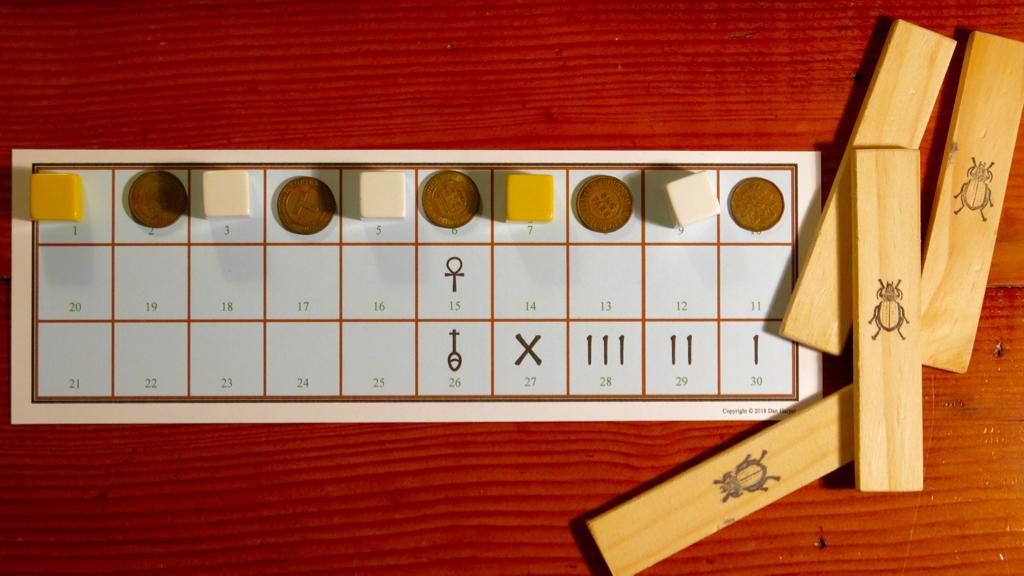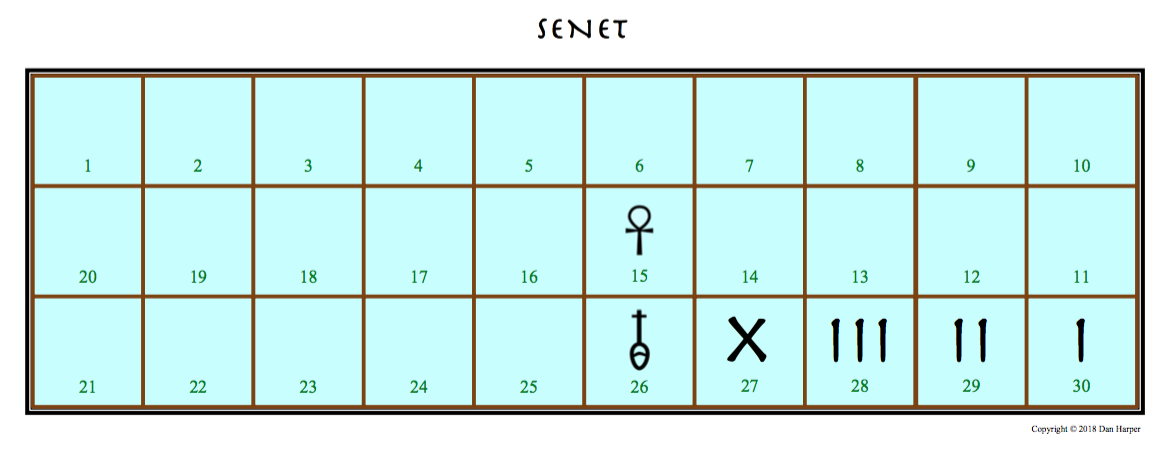Quite a few years ago, when I was visiting the Museum of Fine Arts in Boston (MFA), I saw the ancient Egyptian board game Senet made out of faience (a type of pottery) and wood. Scholars and board-game-lovers have invented modern rules for Senet, based both on ancient Egyptian depictions of people playing Senet and on the several surviving copies of the game. I’ve read through several modern reconstructions of the game, but all the modern rules seem overly complicated. I wanted a set of rules that would be easy for school aged children to learn.
This week I came up with a simple set of rules, rules which remain fairly consistent with what is actually known about the game but are easily learned by school-aged children. The rules are below the fold.
The interesting thing about Senet is that it can be understood to represent the journey of the ba (roughly equivalent to soul) after death through the underworld to some kind of eternal life — it’s not just a game, it’s religion! Some day, I’ll write a lesson plan that ties Senet to ancient Egyptian religion. In the mean time, it’s still a fun game.
Above: The game board I made, printed out and trimmed to size. I used whatever I had around the house for playing pieces — 5 light-colored cubes, and 5 coins (mostly old Boston subway tokens). I made throwing sticks out of some pieces of wood I happened to have (popsicle sticks would work better), and I used a rubber stamp to put an Egyptian scarab beetle on one side so each stick has one clear side and one marked side.
Rules for playing Senet follow….
Senet Game Board (printable PDF)
SENET RULES
Senet was a game played by the ancient Egyptians. No one knows exactly how the ancient Egyptians played Senet, and the rules here are based on reconstructions by several different Egyptologists. This version of Senet is designed for relatively fast play (approx. 20 minutes), and is suitable for ages 8 and up.
Overview of the game:
Your soul, or ba, has entered the realm of the dead through the grand entrance in the Western Desert. You must journey through the realm of the dead and reach the god Osiris, who will let you live forever. But the forces of evil — represented by your opponent’s playing pieces — can get in your way. Will you reach Osiris, or will the forces of evil defeat you?
The object of the game:
Be the first to move all your playing pieces off the board.
Equipment:
5 blue playing pieces and 5 red playing pieces (or two different colors of your choice)
4 throwing sticks (you can also play with a six-sided die)
1 game board
To start:
Arrange the red playing pieces on odd-numbered spaces 1, 3, 5, 7, and 9. Arrange the blue playing pieces on even-numbered spaces 2, 4, 6, 8, and 10. (See the diagram below.)

Both players throw the throwing sticks. The player who throws the lowest takes the blue playing pieces, and goes first. (Or if you use a die, whoever rolls the lowest number goes first.)
How to use the throwing sticks:
The throwing sticks have one marked side and one unmarked side.
1 marked side up, move one square
2 marked sides up, move two squares
3 marked sides up, move three squares
4 marked sides up, move four squares
NO marked sides up, move five squares
Basic play:
Throw the throwing sticks and move one of your playing pieces the number of squares indicated. Move from lower numbered squares up to higher numbered squares (see the diagram below).

If you land on a square that is already occupied, you must send that playing piece back to the square where you started (even if it’s your own playing piece!).
If you cannot move any of your pieces forward, you must move one of your pieces backwards.
If you can’t move any piece forwards or backwards, you lose your turn.
Special squares:
Squares 26, 28, 29, and 30 are “safe” squares. If there is another playing piece on one of those squares, you cannot move your piece there.
Square 27 is the “bad” square. If you land on this square, go back to square 15, and if there is another playing piece already there send it backwards to the next open square.
Moving your playing pieces off the board:
You must move each playing piece off the board by exact count.
Optional additional rule:
Square 26 has the Egyptian symbol nefer, meaning “beautiful” or “good.” Before proceeding to the final four squares, you must land each piece on this square by exact count. (If you play with this rule, the game will take longer.)


